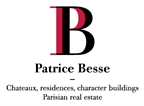An elegant 19th-century dwelling, its outbuildings and enclosed garden in the centre of a village, 25 minutes from Tours - ref 104904
An elegant 19th-century dwelling, its outbuildings and enclosed garden in the centre of a village, 25 minutes from Tours.
Located in the western part of the Centre-Val de Loire region and in the northeast quadrant of the Indre-et-Loire department, the dynamic village in which the property is located includes shops, schools and a doctor's office. Only 25 minutes from the city of Tours and 20 minutes from Amboise, the village, which extends alongside the Brenne River between mostly wooded hillsides and Vouvray wineries, is not far from the Loire Valley, a Unesco World Heritage Site. This bucolic environment with a variety of landscapes also includes practical necessities like a high-speed rail station twenty kilometres away, which provides service to Paris in 55 minutes or the Roissy-Charles-de-Gaulle international airport in less than 2 hours.
From a street in the village centre, the property is accessible via a small door or double gate supported by two tuffeau stone pillars, which is flanked on either side by a low stone wall topped with a wrought-iron fence. These two entrances open onto the partially tree-filled courtyard around which the three buildings are located. A short pathway passes by flowerbeds before reaching the manor house, while a gravel courtyard extends all the way to the outbuilding, bordered by the workshop at a right angle. Clad in finely crafted tuffeau stone, the dwelling's two-storey façades are punctuated by large or small-paned picture windows and topped with a slate hipped roof.
Extending on from the main building, the outbuilding includes a garage on the ground floor and an independent studio in the back. A galleria, the link between the two buildings, includes an enclosed patio at one end that opens onto the garden in the back of the property. Planted with flowerbeds, which define the spaces meant either for relaxation or recreation, the garden gets plenty of sun and is sheltered from view thanks to the property's high walls. In addition, the arched windows topped with glazed fanlights, on the first floor of the house's back façade, bathe the five large upstairs bedrooms in sunlight, while the skylights in the sixth bedroom, built under the eaves, provide this last room with plenty of sunshine.
The DwellingBuilt in 1850 and square in shape, the house faces east and west. The walls of its two main façades are in tuffeau stone, while plaster-covered rubble stone is used on either side of the house, which is topped with a slate hipped roof, punctuated by skylights. On the house's street side, the façade is cadenced by large rectangular windows and doors with moulded surrounds. A cornice marks the division between the ground and first floors, while a second, supported by wide rectangular denticles above a frieze alternating between rosettes and triglyphs, highlights the roof. The small-paned windows on the first floor are decorated with pelmets and wrought-iron guardrails, while on the garden side, the windows, safeguarded by painted wooden shutters, are rectangular on the ground floor and arched on the first floor, with the same guardrails as the street-side façade.
The ground floor
Double wooden doors open onto the entrance hall, extended by a long hallway with a black cabochon tile stone floor, which spans the entire house and leads to the garden. On either side, it provides access to two small sitting rooms, followed by a large living room and a kitchen opposite. The small sitting rooms have marble fireplaces and hardwood floors as well as wainscoting in one and floor-to-ceiling wood panelling in the other, while the walls are painted and the ceilings are decorated with moulding. From one of the sitting rooms, a small hallway with a cupboard and wood panelling leads to the lavatory followed by the kitchen with its tile floor and painted walls. Hidden behind a ...


